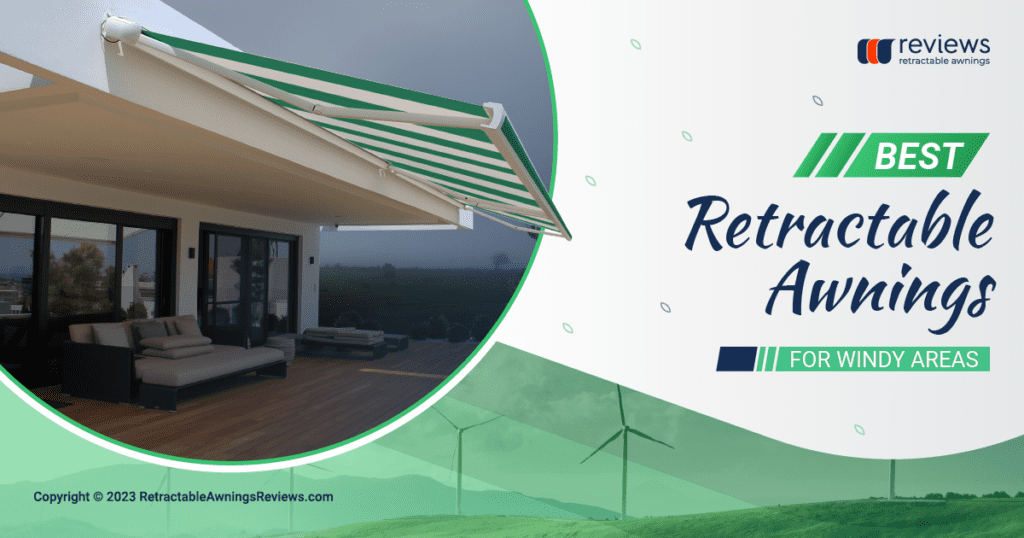Retractable awnings are a great source of shade, and many homeowners and businesses choose them as a shading solution for their properties. Thanks to them, family, friends, and customers stay away from the harmful UV rays and enjoy a fantastic place to relax and unwind.
Retractable awnings can also protect you and your outdoor furniture from light rain, add curb appeal and privacy to your home and reduce the indoor temperature.
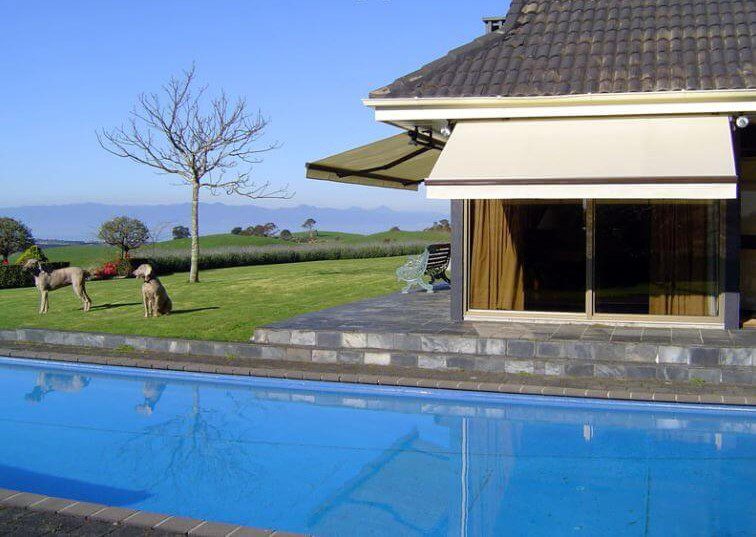
But what happens if you live in a more windy area like Alaska, Wyoming, Michigan, Wisconsin, or Montana? Can retractable awnings withstand wind, and are they worth the investment? How much wind can an awning withstand, and which model is good for the area where you live?
Many online vendors throw around the terms “wind resistant awnings,” “windproof awnings,” and “stormproof awnings,” but what do they mean, and are they good enough for your home or business? Today’s article will shed light on all those questions and discuss the best retractable awnings for windy areas.
Best retractable awnings for windy areas
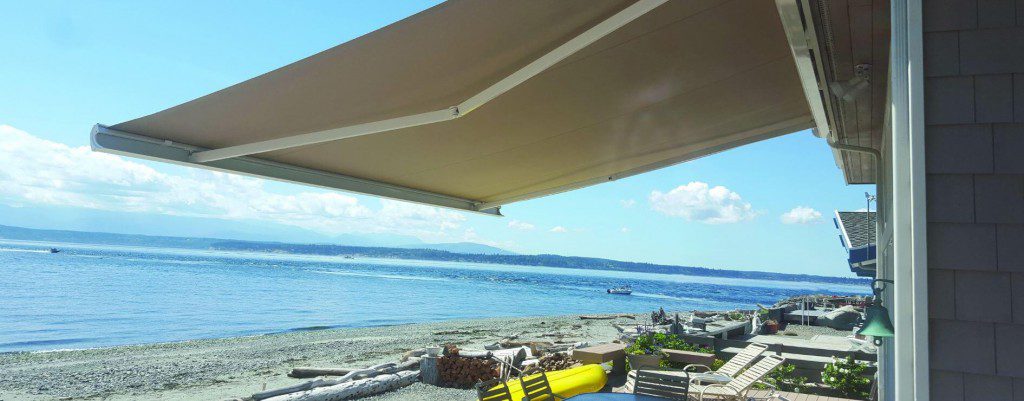
If you live in a windy area, but the summer sun is blazing hot, and you need to create a shady outdoor living space, you might consider installing a quality retractable awning.
But how do you know how much wind can a retractable awning withstand? This section will discuss the retractable awning wind rating and which are the best awnings for windy areas.
Does the vendor mention the model’s Beaufort scale rating?
When looking for retractable wind awnings online, always check if the vendor mentions the Beaufort scale rating on their website. Statements and mentions of any other scales and ratings are pointless when discussing retractable awning resistance in windy conditions.
What is the Beaufort scale?
Britain’s Admiral Sir Francis Beaufort created the Beaufort Wind Scale in 1805. The scale rates wind speeds from 0 to 12 based on visual observations while at sea. Today, each force (0-12) is associated with a specific wind speed range (mph or knots). For a more detailed description of each force, refer to the table below.
| Beaufort scale rating | Description | Speed (mph) | Speed (km/hr) | Speed (knots) |
| 0 | Calm | 0-1 | 0-1 | 0-1 |
| 1 | Light air | 1-3 | 1-5 | 1-3 |
| 2 | Light breeze | 4-7 | 6-11 | 4-6 |
| 3 | Gentle breeze | 8-12 | 12-19 | 7-10 |
| 4 | Moderate breeze | 13-18 | 20-28 | 11-16 |
| 5 | Fresh breeze | 19-24 | 29-38 | 17-21 |
| 6 | Strong breeze | 25-31 | 39-49 | 22-27 |
| 7 | Near gale | 32-38 | 50-61 | 28-33 |
| 8 | Gale | 39-46 | 62-74 | 34-40 |
| 9 | Severe gale | 47-54 | 75-88 | 41-47 |
| 10 | Storm | 55-63 | 89-102 | 48-55 |
| 11 | Violent storm | 64-72 | 103-117 | 56-63 |
| 12 | Hurricane | 72-83 | 118-132 | 64-71 |
*A table of Beaufort scale rating
Retractable awning wind speed testing according to the Beaufort scale
The Beaufort scale speed test is the most reliable wind testing method in the retractable awning industry. Unfortunately, very few of the available models on the market are Beaufort wind load approved, and thus, only some meet the highest standards in the industry.
Keep in mind that most retractable awnings are tested for wind speeds in a controlled lab environment, meaning that outdoor conditions are not always comparable with the testing methods.
For example, a steady breeze would affect an awning differently than irregular gusts. In all cases, it’s essential to know how to protect an awning in high winds, which we will discuss in the last section of this article.
What is the best retractable awning for windy areas?
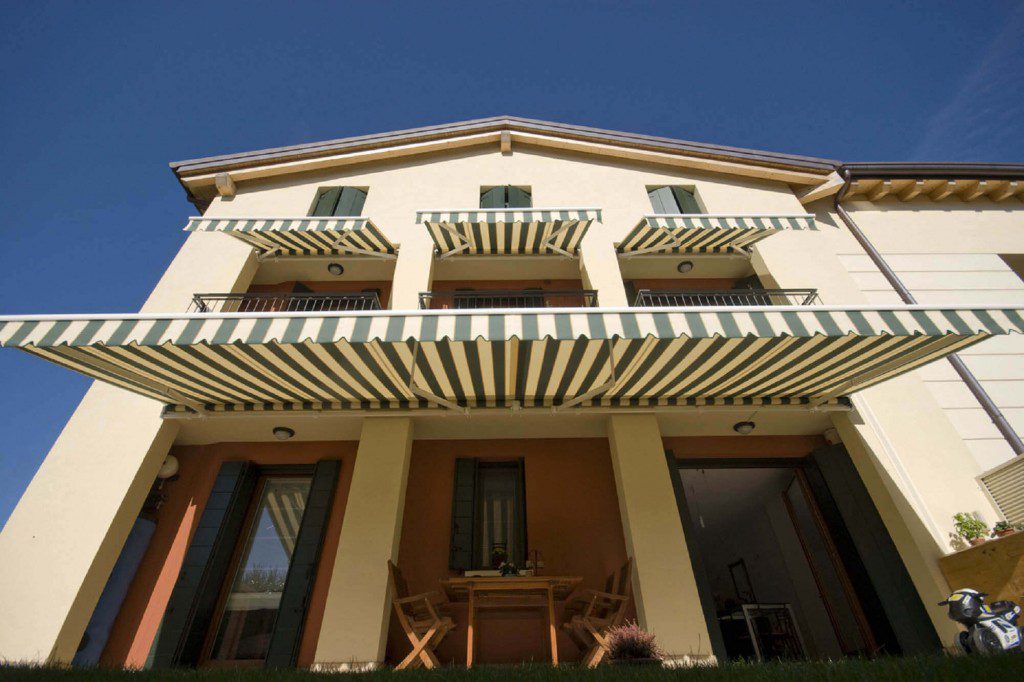
As already discussed, the most reliable wind-resistant retractable awnings are tested according to the Beaufort wind load scale. There are only a few available online, and most of them are offered by the vendor Retractableawnings.com.
We have selected the top 5 windproof retractable awnings to help your research and choice. Remember that the ratings and maximum wind speed resistance refer to the awnings’ capabilities with the arm and fabric fully extended.
1. Retractableawnings.com – Palermo
Palermo is a traditional-designed retractable awning model offered by Retractableawnings.com. Its maximum dimensions are 52’6″ in width and 11’10” projection, with a maximum 60-degree pitch from the horizontal plane. Its Beaufort scale rating is 5, making the retractable awning wind resistant to speeds up to 19-24mph (29-38km/hr).
2. Retractableawnings.com – Palermo Plus
Another extremely reliable retractable awning in windy conditions is the Palermo Plus model by Retractableawnings.com. Its design is traditional, with a maximum width of 52’6″, a projection of 13’2″, and a maximum 70-degree pitch from the horizontal plane. According to the Beaufort scale, the retractable awning wind speed resistance is 5, or up to 19-24mph (29-38km/hr).
3. Retractableawnings.com – Venezia
Venezia is a completely enclosed full cassette retractable awning by Retractableawnings.com. With specifications of a maximum 40-degree pitch, 39’4″ in width, and 13’2″ projection, this model is rated with Beaufort force 4, resisting wind speeds of 13-18mph (or 20-28km/hr).
4. Retractableawnings.com – Roma
Another traditional retractable awning design by Retractableawnings.com is the Roma model. It comes in maximum dimensions of 39’4″ in width, a 16’0″ projection (largest in the world) with a maximum 45 degrees pitch. It is Beaufort-wind-load-tested with a rating of 4, resisting wind speeds of 13-18mph or 20-28km/hr.
5. Shadetreecanopies.com – Shan
Our fifth pick for retractable awnings and wind resistance is the Shan model offered by Shadetreeecanopies.com. It is a full cassette model with a maximum width of 23′, a projection of 13’6″, and a maximum of a 40-degree pitch.
It’s classified with a Class 2 wind resistance according to EN 13561, or up to 18-24mph (29-38km/hr). The vendor does not mention whether or not the model has been Beaufort wind load tested.
Why choose retractable awnings for windy areas?
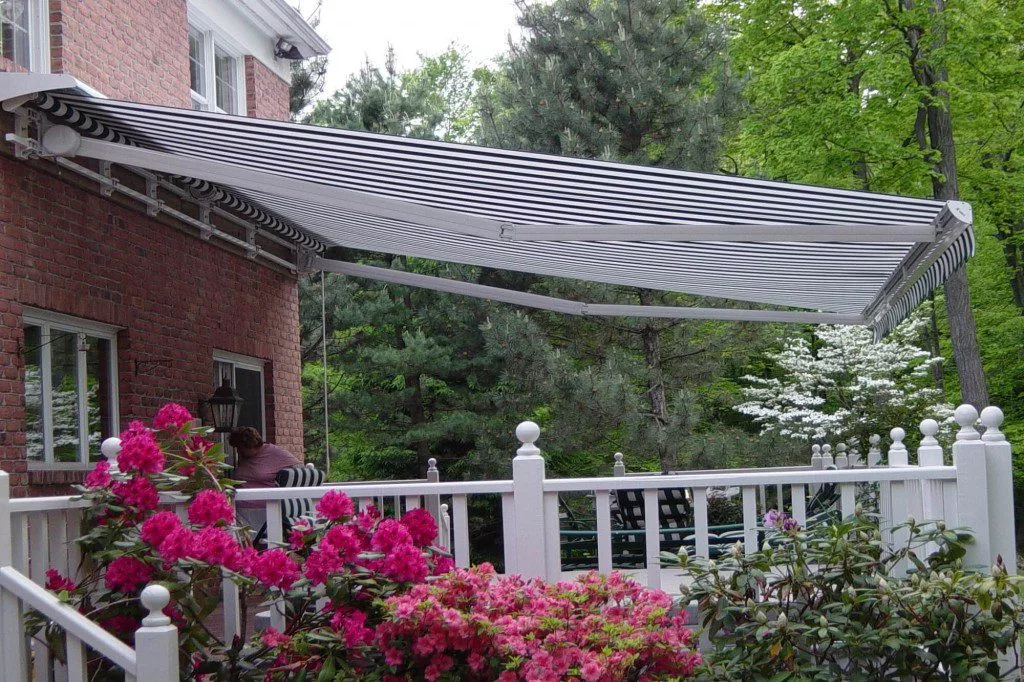
Retractable awnings are more functional than fixed awnings.
Retractable awnings offer more flexibility and are a better choice than fixed patio covers for high wind areas. As opposed to fixed awnings, their mechanism allows full extension or retraction of the fabric. You can retract a retractable roof in case of hazardous weather conditions, thus extending its lifespan and reducing the chance of potential damage.
Built-in high-tech wind/motion sensors
An additional benefit is that you can have a manual retractable awning or motorized (electric) retractable awning. Motorized awnings require a more significant initial investment but offer high-tech shading solutions and seamless convenient control.
If not included in your initial purchase, you can order weather sensors for motorized retractable models. Electric awning wind speed and motion sensors detect wind speed and signal the awning’s motor to activate it and retract it back to a safe position even when you are not at home.
Protecting your retractable awning

Although some retractable awning models like the five mentioned above are more resistant to high wind speeds than others, it’s essential not to forget that you need to protect your awning. When talking about wear and tear caused by the wind, you can take a few precautions to avoid exposing your retractable awning to risks.
Add wind/motion or combined sensors
If you are interested in motorized awnings for high wind areas, I would advise you to consider purchasing either a wind or motion sensor.
Motion sensors are mounted on the awning to detect the motion/movement of the front bar created by wind. They activate when the wind moves the front bar a specific amount and signal the motor to retract the arms/fabric if the front bar moves a specific amount.
Motion sensors are wireless and are battery-operated. Wind sensors activate when the wind reaches a specific amount of wind (anywhere between 12mph and 31mph) and are attached to the wall or fascia adjacent to the retractable awning. Wind sensors work with 100v so they will require a standard 110v GFI outlet.
A combination sensor typically detects sun and wind conditions to ensure safety and a high level of protection. A combination sun and rain sensor will extend the awning at sunrise and close the awning to prevent the pooling of rainwater on the fabric if not enough pitch can be placed on the arms as is the case with most ranch-style homes.
Make sure the awning is well anchored
Another precaution you need to take to protect your retractable awning in case of high-speed winds is proper installation and anchoring. That’s why it’s best to use the correct fastener type and size depending on what the retractable awning will attach to (wood, concrete, concrete block, marble, etc). Best practices show that it’s essential to attach the frame securely to the main building and use telescopic poles for additional front bar support when fully extended.
